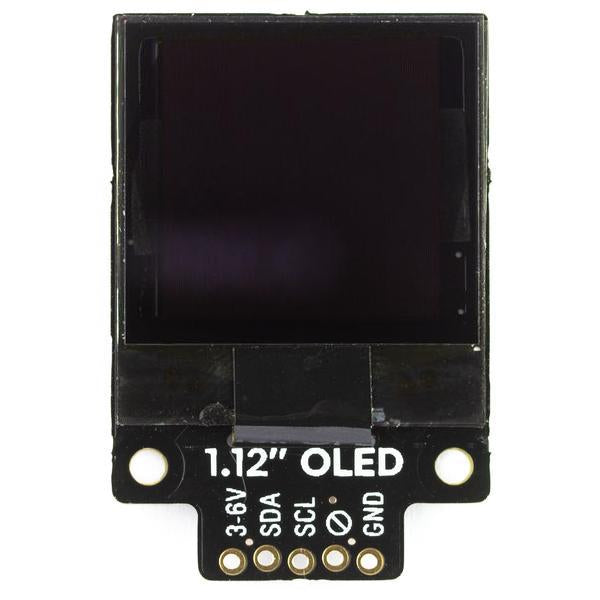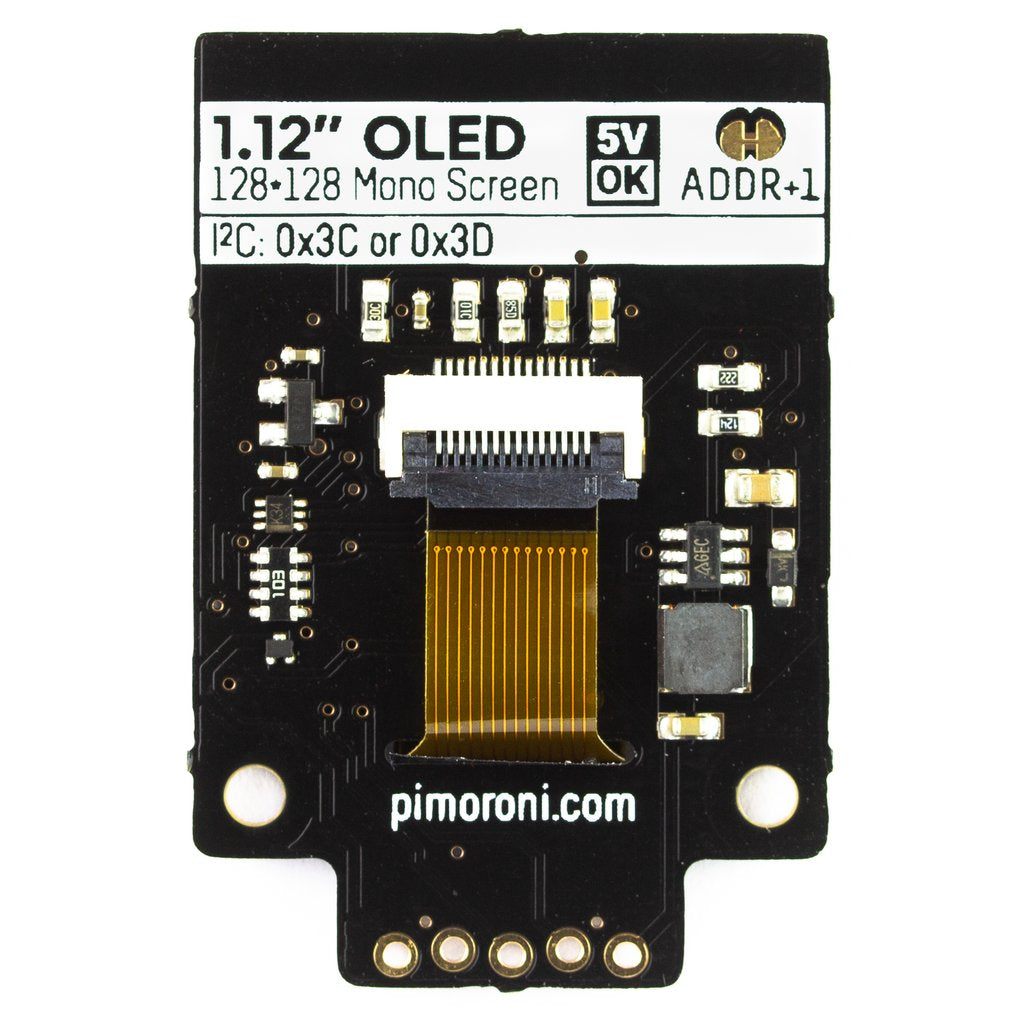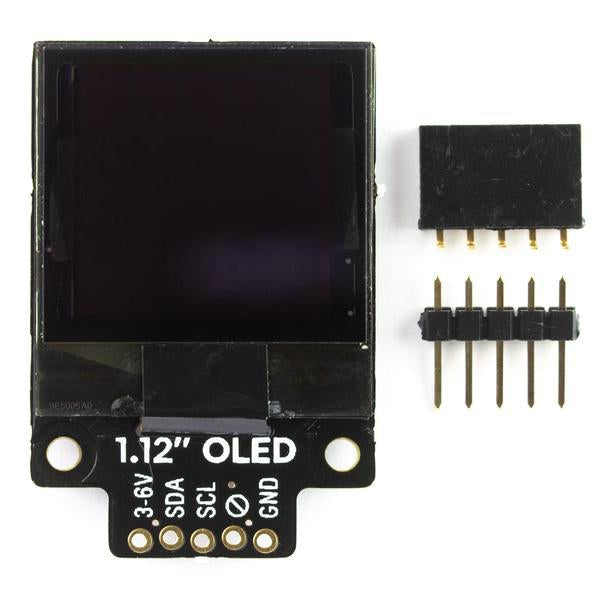Ein Produkt von Pimoroni
Eine scharfe, helle 1,12" OLED, das ideal ist, um ein kleines Display zu Ihrem Projekt hinzuzufügen. Dieses 128x128 Pixel große, monochrome weiß/schwarze Display ist ideal für Grafiken, Anzeigen und einfache Icons. Jetzt als SPI- oder I2C-Variante erhältlich!
Pimoronis 1.12" OLED-Breakout ist jetzt als SPI- oder I2C-Version erhältlich. Wenn Sie SPI auf Ihrem Mikrocontroller zur Verfügung haben, empfehlen wir die SPI-Version, da Sie sie viel, viel schneller ansteuern können, für butterweiche Animationen.
OLEDs haben den Vorteil, dass sie extrem hell und gut lesbar sind und einen hohen Kontrast bieten. Da dieses Gerät klein ist, eignet es sich hervorragend für Projekte, bei denen der Platz knapp ist, und es ist mit Raspberry Pi und Arduino kompatibel!
Bei der I2C-Version hat Pimoroni eine Leiterbahn eingefügt, die abgeschnitten werden kann, um die I2C-Adresse von 0x3C auf 0x3D zu ändern, wenn Sie zwei I2C-OLEDs gleichzeitig verwenden möchten!
Die OLED ist auch kompatibel mit unserem Breakout Garden, in dem man Breakouts einfach in einen der Slots stecken kann, um sein Projekt zu erweitern, zu erstellen und zu programmieren.
Merkmale
- 1,12" weiß/schwarzes OLED-Display (128x128 Pixel)
- Verwendet den SH1107-Treiberchip
- 20x20mm aktive Fläche
- SPI- oder I2C-Schnittstelle (Adresse 0x3C/0x3D (abgeschnittene Spur))
- 3,3V oder 5V kompatibel
- Schutz vor Verpolung
- Kompatibel mit allen Modellen von Raspberry Pi und Arduino
- Python-Bibliothek
Das Kit enthält
- 1.12" OLED-Display-Breakout
- 1x5 (I2C) oder 1x7 (SPI) Stiftleiste
- 1x5 rechtwinklige Buchsenleiste (nur in der I2C-Version enthalten)
Bei der I2C-Version können Sie das Stück der rechtwinkligen Buchsenleiste anlöten und es direkt auf die unteren linken 5 Pins des GPIO-Headers Ihres Raspberry Pi stecken (Pins 1, 3, 5, 7, 9).
Software
Wir empfehlen die Luma Python-Bibliothek für die Ansteuerung dieses OLED-Displays. Die vollständige Dokumentation der Luma-Bibliothek finden Sie hier.
Um loszulegen, sollten Sie:
- Installieren Sie die neueste Bibliothek direkt von GitHub: sudo pip install git+git://github.com/rm-hull/luma.oled.git#egg=luma.oled
- Holen Sie sich das Beispiel-Repository: git clone https://github.com/rm-hull/luma.examples
- Mit der SPI-Version können Sie ein Beispiel wie folgt ausführen: python3 bounce.py --display sh1106 --height 128 --rotate 2 --interface spi --gpio-data-command 9 (fügen Sie --spi-device 0 für den hinteren Steckplatz oder --spi-device 1 für den vorderen Steckplatz hinzu)
- Mit der I2C-Version können Sie ein Beispiel wie folgt ausführen: python3 maze.py --display sh1106 --height 128 --rotate 2 --interface i2c
Pimoronis Software unterstützt Raspbian Wheezy nicht.
Anmerkungen
Abmessungen: 28x42x5.5mm.
English Description
A Pimoroni Product
A crisp, bright 1.12" OLED that's ideal for adding a small display to your project. This 128x128 pixel, monochrome white/black display is ideal for graphing, readouts, and displaying basic icons. Now available in SPI or I2C flavours!
Pimoronis 1.12" OLED breakout is now available in SPI or I2C versions. If you have SPI available on your microcontroller, we'd recommend the SPI version, as you can drive it much, much faster, for buttery-smooth animations.
OLEDs have the advantage of being extremely bright and readable, with great contrast. Because this one is small, it's great for fitting into projects where space is at a premium, and it's Raspberry Pi and Arduino-compatible!
On the I2C version, Pimoroni has included a trace that can be cut to change the I2C address from 0x3C to 0x3D, if you want to use two I2C OLEDs at once!
It's also compatible with our fancy Breakout Garden, where using breakouts is as easy just popping it into one of the slots and starting to grow your project, create, and code.
Features
- 1.12" white/black OLED display (128x128 pixels)
- Uses the SH1107 driver chip
- 20x20mm active area
- SPI or I2C (address 0x3C/0x3D (cut trace)) interface
- 3.3V or 5V compatible
- Reverse polarity protection
- Compatible with all models of Raspberry Pi, and Arduino
- Python library
Kit includes
- 1.12" OLED display breakout
- 1x5 (I2C) or 1x7 (SPI) male header
- 1x5 female right-angle header (only included with I2C version)
With the I2C version, you can solder on the piece of right-angle female header and pop it straight onto the bottom left 5 pins on your Raspberry Pi's GPIO header (pins 1, 3, 5, 7, 9).
Software
We recommend the Luma Python library for driving this OLED display. You can find full documentation for the Luma library here.
To get up and running you should:
- Install the latest library directly from GitHub:
sudo pip install git+git://github.com/rm-hull/luma.oled.git#egg=luma.oled - Grab the examples repository:
git clone https://github.com/rm-hull/luma.examples -
With the SPI version, you can run an example like so:python3 bounce.py --display sh1106 --height 128 --rotate 2 --interface spi --gpio-data-command 9(add--spi-device 0for the back slot, or--spi-device 1for the front slot) - With the I2C version, you can run an example like so:
python3 maze.py --display sh1106 --height 128 --rotate 2 --interface i2c
Pimoronis software does not support Raspbian Wheezy.
Notes
Dimensions: 28x42x5.5mm.
Sicherheitsangaben
- Lesen Sie die Bedienungsanleitung sorgfältig durch, bevor Sie das Produkt verwenden.
- Stellen Sie sicher, dass alle Montage- und Installationsanweisungen des Herstellers sorgfältig befolgt werden.
- Verwenden Sie das Produkt nur für den vorgesehenen Zweck.
- Die unsachgemäße Nutzung dieses Produkts kann zu schweren Verletzungen oder Sachschäden führen.
- Nicht für Kinder unter 10 Jahren geeignet.
- Bei unsachgemäßer Verwendung besteht eine Verletzungsgefahr.
- Dieses Produkt entspricht den geltenden Sicherheitsanforderungen der Europäischen Union.
- Dieses Produkt wurde gemäß der GPSR geprüft, die sicherstellt, dass alle relevanten Sicherheitsanforderungen für Konsumgüter eingehalten werden.
Nachverfolgbarkeitsinformationen
Jedes Produkt verfügt über eines oder mehrere der folgenden Merkmale:
- Ein CE-Kennzeichen, das die Einhaltung der Sicherheits-, Gesundheits- und Umweltschutzanforderungen der Europäischen Union anzeigt.
- Eine eindeutige Serien- oder Chargennummer, um die Nachverfolgbarkeit zu gewährleisten und bei Bedarf Rückrufaktionen zu unterstützen.
- Hersteller- und Importeurangaben für den Kundensupport und Sicherheitsanfragen.
Überwachung und Berichterstattung von Vorfällen
Für den unwahrscheinlichen Fall eines Produktproblems haben wir Verfahren implementiert, um:
- Kundenbeschwerden zeitnah bearbeiten.
- Schwerwiegende Vorfälle über das EU Safety Gate/RAPEX-System melden.
- Mit den Marktüberwachungsbehörden zusammenarbeiten, um die öffentliche Sicherheit zu gewährleisten.
Kontakt:
- Email: support [@] pi3g.com
- Telefon: 0341 / 392 858 40
Dieses Produkt ist vollständig mit allen geltenden EU-Vorschriften konform, um die Sicherheit unserer geschätzten Kunden zu gewährleisten.



